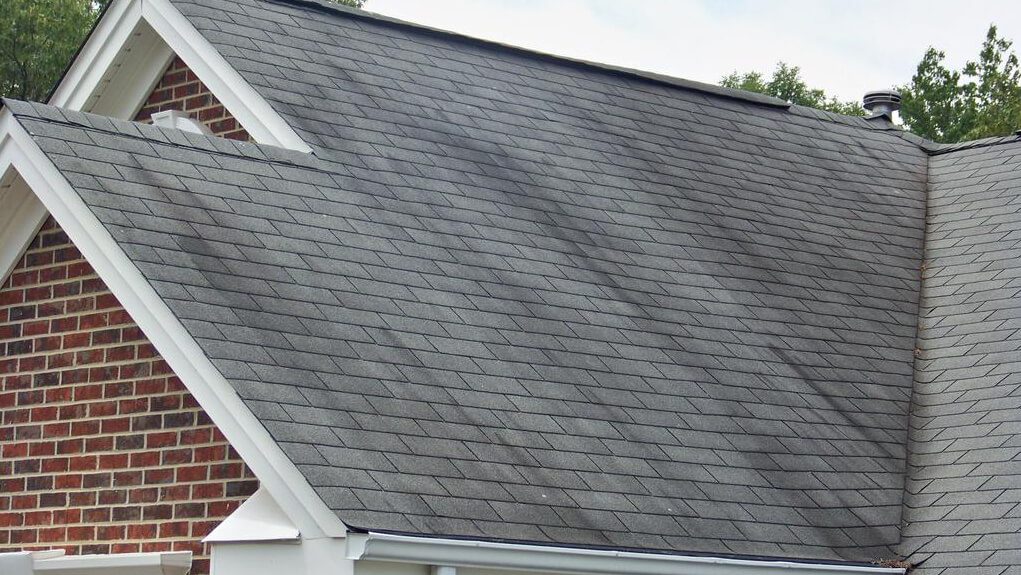Post Oak Roofing explains what to do about roof streaks. Black streaks on a shingled roof are rather frequent, albeit not desired. While black streaks on asphalt shingle roofs won´t cause immediate harm, they can promote premature roof aging.

What causes black streaks on roofs? How can you remove them, and how can you prevent them from re-occurring? We’ll give answers to these questions below.
Causes of Roof Streaks
Your roof may develop black streaks due to several reasons:
· Algae – Gloeocapsa magma
Algae is the most prevalent cause of black streaks on asphalt roofs.
Gloeocapsa magma is a blue-green alga that hardens and darkens, leaving black spots on your asphalt roof. This alga feeds on any limestone in your asphalt shingle roof and makes it weaker over time.
Also, the algae will become larger and more evident each year, collecting moisture, and promoting accelerated aging of your shingles. You should remove it as soon as possible to prevent shingle decay.
· Mold or mildew
Mold or mildew can also generate streaks and stains on your roof. These elements quickly grow on your roof during humid seasons. This causes dampness on your roof, which promotes damage and worsens mold and mildew growth.
To safeguard the integrity of your roof, don’t use a high–pressure washer on these discolored patches. You may accidentally damage your shingles and aggravate the issue.
· Dirt
Falling leaves and branches, dirt, sticks, and other weather conditions may discolor your roof. So, cleaning this requires a safety ladder, traction shoes or boots, and rubber gloves. But always proceed with caution when cleaning.
Rake an asphalt shingle roof from top to bottom to prevent pulling shingles up. Likewise, a garden hose can remove any persistent dirt patches.
Again, avoid using a power washer to avoid more roof damage. If you don´t have the skills or confidence to clean your roof, you may hire a professional to do it for you.
Roofing Materials Susceptible to Algae
Algae thrive situations. They love shady, wet, humid places with enough nutrients. Wood and asphalt shingles are more prone to algae growth, which is why many homeowners choose metal roofs for their houses.
Black streaks on asphalt shingle roofs are the most prevalent, possibly due to their popularity and ability to attract algae.
Check your asphalt shingle roof often for indications of algae growth to help avoid premature aging.
How Do I Get Rid of Black Streaks?
If your roof has black stains, hiring a roofing professional to remove them is the best option. The major reason is that cleaning or repairing shingles on your roof is risky.
Falling is a severe risk if you don´t have the correct safety gear or experience. Also, if you don´t have the right abilities or experience you might wind up hurting your roof, resulting in higher repair bills.
Remember that power washing an asphalt shingle roof may easily harm the shingles. Instead, clear algae stains thoroughly and gently. Besides, aggressive cleaning chemicals might harm the life of your asphalt shingle roof.
Cleaning black streaks off an asphalt shingle roof requires water, bleach, and trisodium phosphate (TPS). Also, remember to protect your roof plants from this mix as it might harm them.
Moreover, consider that using oxygen bleach instead of chlorine bleach is healthier for the environment.
Here’s what to do about roof streaks.
Do you want to know how to avoid black streaks on your roof? Keep in mind that algae and black streaks will return unless you take proactive measures.
Install a cooper or zinc-coated sheet metal strip down each side of your roof, just below the ridge. For this method to work, between 2 and 4 inches of metal must be visible.
Copper and sheet metal are harmful to algae. Copper is more effective and toxic to algae, although galvanized sheet metal is less costly. These thin metal panels may be mounted to your roof with nails or screws and rubber washers.
Installing algae-resistant asphalt shingles on your property is another option. Also, trim any overhanging branches from adjacent trees to keep your roof free of leaves and debris.
On the other hand, inexperienced roofers should never try DIY roofing projects. Roofing jobs are usually risky and require expertise. Consult a specialist if you want to change your shingles or install metal strips to prevent algae recurrence.
New Roofs from Post Oak Roofing
Is your algae development out of control? Do you want to change your roof to a more algae-resistant material? Post Oak Roofing can assist you.
While DIY roofing repairs, maintenance, and replacements may save money in the short term, professional attention is required to ensure many years of service from your roof.
Make an appointment with the Post Oak Roofing team now to have all your roofing questions addressed. We service Allen, Tyler, Plano, McKinney, DFW, TX, and surrounding areas. Contact us today at 469-363-6273 for more information.
